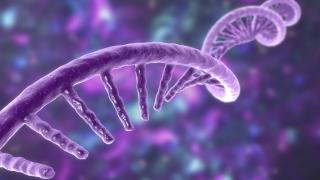Scientists with City of Hope® and the Translational Genomics Research Institute (TGen), part of City of Hope, may have discovered one of the reasons why a type of leukemia sometimes develops into a more aggressive form, according to recent research published in Nature Communications.

Led by Guido Marcucci, M.D., City of Hope professor and chair of the Department of Hematologic Malignancies Translational Science, director of the Gehr Family Center for Leukemia Research, and chief of the Division of Leukemia, and Bin Zhang, Ph.D., associate professor in City of Hope’s Department of Hematologic Malignancies Translational Science, the research team analyzed the RNA of chronic myeloid leukemia cells (CML) and found that miR-142, an RNA molecule that regulates cell metabolism, was missing.
Researchers hypothesized that the lack of this small RNA molecule has important implications, as its absence allows CML cells to expand and eventually develop into a more aggressive form of the disease called blastic phase (BP), which is the equivalent of secondary acute myeloid leukemia (sAML). SAML is deadly and has limited treatment options.
The team developed a synthetic version of miR-142 and tested it in mouse models of BP CML. They found that adding miR-142 prevented CML transformation. Some mice with BP CML were even cured of their disease.
Researchers also found that adding tyrosine kinase inhibitors, a Food and Drug Administration-approved therapy for CML, increased the anti-leukemic activity of the synthetic miR-142.
New Pathway to Treatment
“What’s exciting is that we have potentially discovered how we can knock down the leukemia stem cells, which are the equivalent to the ‘queen bees’ of the disease, and a way we can keep them from producing more cancer cells,” Zhang said.
The only current curative option for CML that has developed into BP is a blood marrow or stem cell transplant. A transplant may not work in some patients or can create serious side effects.
“More options are urgently needed for these patients. Our team will now work on developing synthetic miR-142 therapy for use in patients in clinical trials, hopefully as soon as next year,” Marcucci said.
Leveraging TGen’s unique molecular profiling platforms, this study also uncovered that the loss of mIR-142 in CML causes major changes in tumor metabolism.
“These key metabolic changes are at the heart of the transformation of CML into blast crisis, which, unfortunately, is associated with poor treatment options,” said Patrick Pirrotte, Ph.D., associate professor at TGen and director of City of Hope’s Integrated Mass Spectrometry Shared Resource. “These new molecular findings provide interesting new avenues for therapies.”
The CML research can also be applied to finding better treatments for myeloproliferative neoplasms, since both are diseases of the bone marrow.
The research was funded by the Robert & Lynda Carter Altman Family Foundation Research Fund in honor of actress, singer-songwriter and advocate Lynda Carter Altman’s late husband, Robert, who developed myelofibrosis, a myeloproliferative neoplasm of the bone marrow, which eventually transformed into sAML.
The Carter Altman fund supports City of Hope and TGen’s two-track approach to developing leading-edge diagnostic and treatment technologies for myeloproliferative neoplasms and their transition into sAML. One track funds research such as that led by Marcucci and his team and focuses on accelerated development of new medicines with the goal of enabling first-in-human clinical trials of investigational new therapies to mitigate disease progression.
Another track funds a diagnostic project at TGen using genomic sequencing to uncover strategies to pinpoint and prevent disease progression.
“Current gene-based information of patients with myeloproliferative neoplasms and AML rely on a ‘Cliffs Notes’ version (several hundred of our 22,000 genes) that require two weeks or more to obtain. Thanks to the Carter Altman Foundation, the TGen team is viewing all 3 billion letters of a patient’s genome in two days or less. In today’s era of mining massive data, we believe this new tool can uncover more information more quickly, offering greater benefit to patients," said Jeffrey Trent, Ph.D., TGen president and research director, and the project leader at TGen.
Main image: A model of mRNA.
